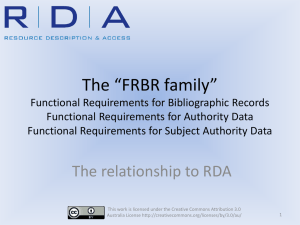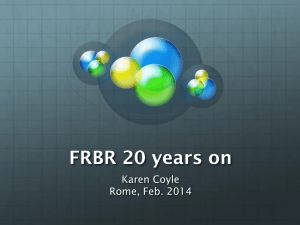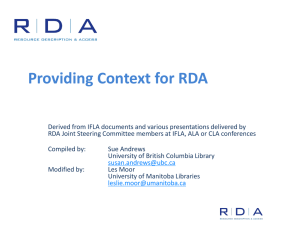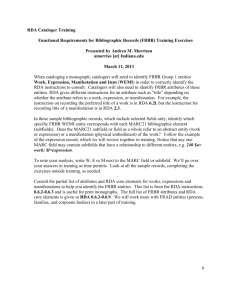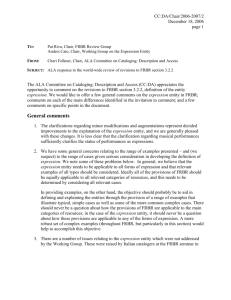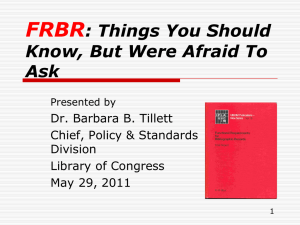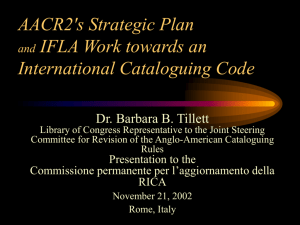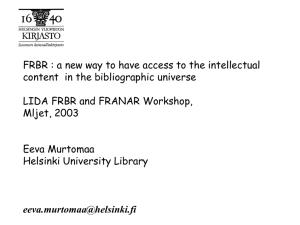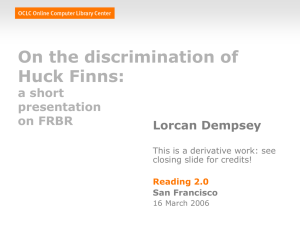the relationship to RDA
advertisement
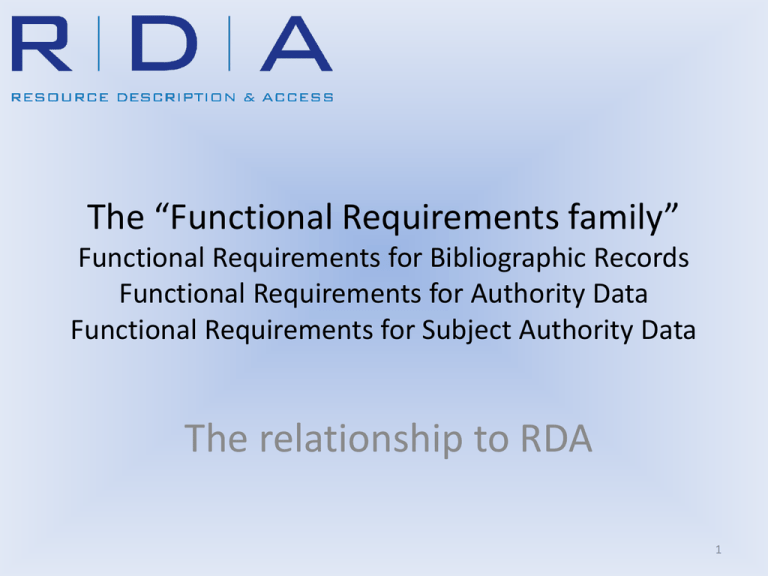
The “Functional Requirements family” Functional Requirements for Bibliographic Records Functional Requirements for Authority Data Functional Requirements for Subject Authority Data The relationship to RDA 1 “Functional Requirements family” history • Functional Requirements for Bibliographic Records – 1998- FRBR conceptual model published • Functional Requirements for Authority Data – 2009- FRAD conceptual model published • Functional Requirements for Subject Authority Data – 2010- FRSAD conceptual model published 2 FRBR, FRAD and FRSAD What they are • They are conceptual models to explain the purpose of bibliographic and authority records and how they relate to the needs of users • They provide a common understanding and vocabulary to enable cataloguers around the world to discuss cataloguing concepts, independent of any particular cataloguing rules or system 3 FRBR, FRAD and FRSAD What they are not • They are not cataloguing rules • They are not data models • They do not prescribe how the models might be implemented in online catalogues 4 What is FRBR? • FRBR is a structured framework for – relating the data recorded in bibliographic records to the needs of users – relating bibliographic records to each other • FRBR defines what data users expect to find in a bibliographic record and how they use that information 5 What do users expect from a library catalogue? • Users expect that a library catalogue will enable them to FIND a work/item of intellectual or artistic content that meets their needs – For example • by a particular author • on a particular subject • with a certain title 6 What do users expect from a library catalogue? • Users expect that a library catalogue will enable them to IDENTIFY a work/item of intellectual or artistic content that meets their needs – For example • to distinguish between items with the same title 7 What do users expect from a library catalogue? • Users expect that a library catalogue will enable them to SELECT a work/item of intellectual or artistic content that meets their needs – For example • to check that an item is in a suitable form for a particular group, such as the vision impaired 8 What do users expect from a library catalogue? • Users expect that a library catalogue will enable them to OBTAIN a work/item of intellectual or artistic content that meets their needs – For example • to request the item • to access a remote resource 9 What do users expect from a library catalogue? • Users expect bibliographic records to help them find, identify, select and obtain the products of intellectual or artistic endeavour 10 Intellectual or artistic activity and content Physical characteristics Work Expression Manifestation Item 11 Item • A concrete entity – the Library’s copy of Tim Winton’s Cloudstreet, as first published in 1991 by McPhee Gribble 12 Manifestation • All the physical or virtual objects that bear the same characteristics, in respect of intellectual content and form – The entire print run by McPhee Gribble in 1991 of Tim Winton’s Cloudstreet 13 Expression • Intellectual or artistic form, such as language, alpha-numeric or musical or choreographic notation, sound, image, object, movement, etc, or a combination of these – The English language and alpha-numeric text of Tim Winton’s Cloudstreet 14 Work • The intellectual or artistic creation as an abstract entity – The characters and plot of Tim Winton’s Cloudstreet 15 Attributes of a Work • • • • • • • • Title Date Form (e.g. poem, map, painting) Intended termination Intended audience Context Coordinates and Equinox (Cartographic works) Medium of performance, Numeric designation and Key (Musical works) • Any other characteristic that serves to differentiate a work from another of the same title 16 Attributes of an Expression • • • • • • • • • • • • Title Form (e.g. alpha-numeric notation, spoken word, mime) Date Language/s Extensibility (e.g. future volumes in a multi-vol.) Revisability (e.g. draft or integrating resource) Extent (e.g. number of words, duration of performance) Summarization (e.g. abstract, table of contents) Context Critical response Use restrictions Any other characteristic that serves to differentiate an expression from another expression of the same work 17 Attributes of an Expression • Serial • Remote sensing image – Sequencing pattern – Expected regularity – Expected frequency – Recording technique – Special characteristic – Type of score – Medium of performance – – – – – • Musical notation • Sound recording – Medium of performance • Graphic or Projected image • Cartographic image or object Scale Projection Presentation technique Representation of relief Geodetic, Grid, and Vertical measurement – Technique 18 Attributes of a Manifestation • Title • Statement of responsibility • Edition/Issue designation • Imprint (place, date, publisher, manufacturer) • Series statement • Identifier (e.g. ISBN) • Physical description (form, extent, composition, dimensions) • Capture mode • Source of acquisition • Terms of availability • Access restrictions 19 Attributes of a Manifestation • Printed book – Typeface – Type size • Hand printed book – Foliation – Collation • Serial – Numbering • Microform – Polarity – Generation – Reduction ratio • Sound recording – Kind of sound – Playing speed – Groove width and kind of cutting – Tape configuration • Electronic resource – – – – System requirements File characteristics Mode of access Access address • Image – Colour 20 Attributes of an Item • • • • • • • Identifier (e.g. accession number, call number, barcode) Provenance Marks and inscriptions Torn or missing pages Exhibition history Treatment history Access restrictions 21 WORK EXPRESSION MANIFESTATION ITEM 100 1_ $aWinton, Tim,$d1960240 10 $aCloudstreet.$lGerman 245 13 $aDas Haus an der Cloudstreet :$bRoman / $cTim Winton ; aus dem australischen Englisch von Barbara Lehnerer 260 __ $aFrankfurt am Main :$bKruger,$c1998. 300 __ $a 493 p. ;$c22 cm. 700 1_ $aLehnerer, Barbara,$etranslator. 900 __ $aLibrary’s copy signed by the author. Functional requirements for bibliographic records : final report / IFLA Study Group on the Functional Requirements for Bibliographic Records, 2008, p. 14, “Group 1 entities and primary relationships”, Figure 3.1 23 Equivalent relationships • Most commonly between the various manifestations of an expression of a work – Alternate • Simultaneously released edition • Alternate format – Reproduction • Reprint • Mirror site • Facsimile Derivative relationships • Work-to-Work or Expression-to-Expression – Different Expressions of the same Work • • • • • Revision Literal translation Musical arrangement Dubbed or subtitled version of a film Illustrated edition – A new Work based on another Work • • • • Adaptation for children Parody Free translation Screenplay Descriptive relationships • A new Work that describes one or more existing Works, Expressions, Manifestations or Items – – – – Review Criticism Commentary Annotated edition The Epistle of James : a commentary on the Greek text / by Peter H. Davids Nimbus of glory : a study of Coleridge's three great poems / by Warren Stevenson Relationships in the Organization of Knowledge, edited by Carol A. Bean and Rebecca Green, 2001, p. 23, “Bibliographic Relationships” by Barbara B. Tillett, Figure 2, © 2001 Kluwer Academic Publishers Boston, with kind permission of Kluwer Academic Publishers. 27 Work Cloudstreet (Book discussion notes) Cloudstreet (Novel) Cloudstreet (Play, 1998) Expression German translation English language text English language text Manifestation Kruger, 1998 McPhee Gribble, 1991 Reprint (McPhee Gribble, 1993) Currency Press, 1999 Whole-Part relationships • Relationship between a Work, Expression, Manifestation or Item and its component parts – Dependant parts • chapters, sections, parts, volumes • illustrations for a text • sound aspect of a film – Independent parts • • • • monograph in a series journal articles parts of a kit books of the Bible 29 Sequential relationships • Sequential – Sequel • Zen and the modern world : a third sequel to Zen and Western thought / Masao Abe ; edited by Steven Heine – Prequel • Wide Sargasso Sea / Jean Rhys – Prequel to: Jane Eyre / Charlotte Brontë – Multi-part series, where the parts relate to each other 30 Accompanying relationships • Supplementary – May be dependent or independent • appendix • supplement • Companion • music written for an existing poem 31 Contextual relationships • Relationship between Work or Expression or Manifestation or Item and • Person/s or Family/Families or Corporate body/bodies responsible for – intellectual or artistic content – physical production or dissemination – custodianship 32 Work Expression PERSON FAMILY CORPORATE BODY Manifestation Item 33 FRAD user tasks • Find person/s, family/families, corporate body/bodies, works, etc based on known information • Identify – Confirm person or family or corporate body or work, etc is the one sought • Contextualize – clarify the relationship between entities, such as earlier and later names of a corporate body • Justify the controlled access point Attributes of a Person • • • • • • Dates Title Gender Place of birth Place of death Country with which the person is identified • Place of residence • Affiliation • • • • Address Language Field of activity Profession or occupation • Biography or history • Any other information by which a person is known or identified Attributes of a Family • Type of family – Clan, dynasty, family unit • Dates associated with family • Field of activity • History of family Attributes of a Corporate Body • • • • • • • Place associated with corporate body Dates associated with corporate body Language Address Field of activity History Any other information that differentiates one corporate body from another Work Expression Manifestation Item WORK Person Family Corporate body Concept Object Event Place 38 FRBR and RDA • FRBR and FRAD concepts, terms and user tasks • RDA content and organisation reflect FRBR and FRAD – Attributes – Relationships 39 RDA structure • Section 1: Recording Attributes of Manifestation & Item – All physical formats, not one per chapter – Describing carriers • Section 2: Recording Attributes of Work & Expression – Describing content • Section 3: Recording Attributes of Person, Family, & Corporate Body • Section 4: Recording Attributes of Concept, Object, Event & Place – Concept, Object, Event are placeholders at this stage 40 RDA structure • Section 5: Recording Primary Relationships between Work, Expression, Manifestation, & Item • Section 6: Recording Relationships to Persons, Families, and Corporate Bodies • Section 7: Recording Relationships to Concepts, Objects, Events, & Places • Section 8: Recording Relationships between Works, Expressions, Manifestations , & Items • Section 9: Recording Relationships between Persons, Families, & Corporate Bodies • Section 10: Recording Relationships between Concepts, Objects, Events, & Places (Placeholder) 41 RDA, FRBR and the future • Library systems will evolve to fully display FRBR structure of work, expression, manifestation, and item • Application of FRBR concepts to traditional catalogue records – Trove - http://trove.nla.gov.au/ 42 Virtua ILS (VTLS) Display created using linked data 43 RDA, FRBR and the future • Application FRBR concepts in other systems • Australian Music Centre catalogue http://www.australianmusiccentre.com.au/search • Austlit - http://www.austlit.edu.au/ 44 Where to find out more • FRBR family of models – http://www.ifla.org/en/node/2016 – Report of Working Group on Aggregates • http://www.ifla.org/en/node/923 • FRBRoo – an object-oriented version of FRBR for museum information • http://www.cidoc-crm.org/frbr_drafts.html • Namespaces for Functional Requirements family – http://iflastandards.info/ns/fr/ 45 Acknowledgments • Parts of this presentation have been copied from presentations by Deirdre Kiorgaard, Barbara Tillett, Alan Danskin and John Attig 46
